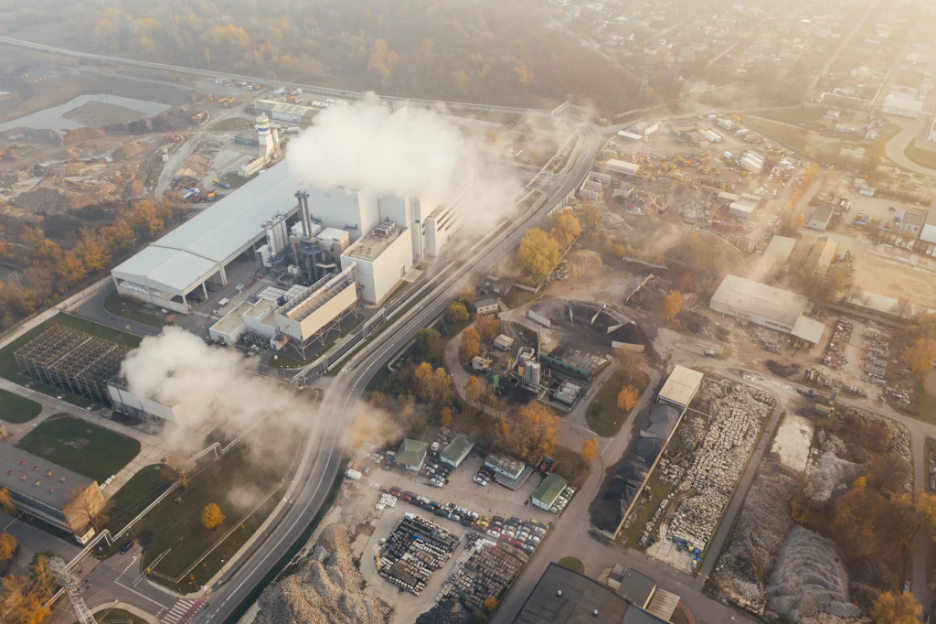The petrochemical industry powers many of the products we use every day, from plastics and fertilizers to medical supplies and batteries. However, this vital sector also carries a significant carbon footprint, contributing heavily to global emissions.
So, the challenge is clear: how to grow the industry while cutting carbon emissions. Let’s explore where these emissions come from, the strategies to reduce them, Egypt’s evolving policies, and how partners like Anchorage Investments are helping steer the sector toward a greener future.

Sources of Carbon Emissions in Petrochemicals
The petrochemical industry is a major source of carbon emissions, mainly from the downstream processes where raw materials like natural gas and oil are turned into plastics, fertilizers, and methanol. These processes use carbon-rich feedstocks and a lot of energy, making petrochemicals one of the top three industrial contributors to CO2 emissions, alongside cement and steel.
For example:
- Ammonia production accounts for about 1.4% of global CO2
- Plastic production was responsible for approximately 2 billion tons of CO2 equivalent in 2015, projected to rise to 6.5 billion by 2050.
- Methanol emits roughly 0.99 kg of CO2 per kilogram produced, higher than cement.
Carbon Capture, Utilization, and Storage (CCUS)
Carbon Capture, Utilization, and Storage (CCUS) is a key strategy for reducing CO2 emissions from petrochemical operations. It encompasses three interlinked steps:
- Capture: Advanced technologies, such as post-combustion amine systems, can isolate 85–95% of CO2 from flue gases in facilities like hydrogen or ammonia plants
- Utilization: A portion of captured CO2 is converted into products like methanol, urea, or synthetic fuels. However, most captured CO₂ is currently reserved for storage rather than reuse.
- Storage: The CO2 is injected into geological formations, such as depleted reservoirs or saline aquifers.
The global capacity to capture CO2 rose to approximately 47 million tonnes in 2022, reflecting growth in CCUS adoption, but this still represents a small fraction of global emissions
Low‑Carbon Feedstocks and Processes
One of the most effective ways to reduce carbon in petrochemicals is by substituting fossil feedstocks with low‑carbon alternatives. These replacements help lower emissions at the source without needing downstream treatment:
- Bio‑based feedstocks: materials like agricultural waste and used cooking oil substitute fossil inputs in key chemicals.
- Recycled carbon: converts plastic waste back into feedstock, closing the carbon loop.
- CO2‑based and synthetic routes: leverage captured CO2 and green hydrogen to produce chemicals with lower net emissions.
Scope 1, 2, and 3 Emissions Explained

Reducing emissions in the petrochemical sector starts with knowing where they come from. The Greenhouse Gas Protocol classifies emissions into three categories: Scope 1, 2, and 3, based on whether they are direct or indirect, and who controls the source.
- Scope 1: Direct emissions from company-controlled sources (e.g., fuel combustion).
- Scope 2: Indirect emissions from purchased energy generation.
- Scope 3: Indirect emissions from the broader value chain, often the largest and hardest to reduce, requiring collaboration with suppliers and customers.
Role of Carbon Credits and Offset Programs
Carbon credits and offset programs are often used by petrochemical companies to balance out emissions they can’t immediately eliminate. A carbon credit represents one metric ton of CO2 avoided or removed from the atmosphere. These credits can be purchased to compensate for direct and indirect emissions, especially Scope 3, which are typically the hardest to reduce.
As for offset programs, they fund projects like reforestation, renewable energy, or methane capture. While they don’t address emissions at the source, they offer a temporary path toward carbon neutrality.
Policy and Regulatory Frameworks
Central to Egypt’s green transition is the National Climate Change Strategy 2050, which outlines sector-specific targets to reduce emissions by 65% for oil and gas by 2030, contingent on international financial support. This strategy is being operationalized through the National Adaptation Plan, set to be completed in 2025 .
In the petrochemical sector, the government has introduced incentives for green hydrogen projects. A draft law approved in May 2023 offers tax exemptions, including VAT waivers and land registration fee reductions, to encourage investment in green hydrogen and ammonia projects.
Renewable Energy Integration for Emission Reduction
Egypt aims to increase the share of renewable energy in its electricity generation mix to 42% by 2030. This includes plans to close 5 GW of inefficient oil and gas power generation capacity and facilitate private investment to create 10 GW of new renewable energy capacity.
Besides that, the government is investing in green hydrogen and ammonia projects, with agreements totaling $33 billion signed with European developers in June 2024.
Egypt’s Efforts to Reduce the Carbon Footprint in the Petrochemical Sector
Egypt is actively pursuing a green transition in its petrochemical sector through several strategic initiatives. The government has committed $1.2 billion to environmentally friendly projects aimed at reducing emissions by 2.1 million tons annually. Other notable projects include a $600 million polylactic acid plant utilizing agricultural waste, a $112 million bioethanol facility in Damietta Port, and a €284 million medium-density fiberboard factory in Beheira Governorate.
Additionally, the Egyptian Petrochemicals Holding Company (ECHEM) is collaborating with the UAE’s Rega Energy to produce algae oil for bio-jet fuel and green naphtha in New Alamein City.
Anchorage Investment: A Model for Green Petrochemicals
Anchorage Investment, led by Dr. Ahmed Moharram, is driving innovation in low-carbon petrochemical production through its flagship project, Anchorage Benitoite. The plant will use renewable energy and captured carbon to produce methanol with a significantly lower emissions profile. It stands as a regional benchmark for how private-sector investment can support sustainable industrial growth while aligning with Egypt’s climate goals.
Final Thoughts
Egypt’s commitment to a green transition in its petrochemical sector is evident through its strategic policies, regulatory incentives, and substantial investments in renewable energy and sustainable practices. These efforts align with the nation’s broader goals under Vision 2030 and the National Climate Change Strategy 2050, positioning Egypt as a regional leader in sustainable industrial development.